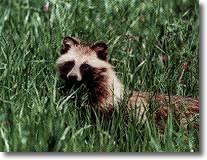




The animals to the left are tanuki, or more scientifically, Nyctereutes procyonoides. Prosaically they are raccoon dogs. They come in six subspecies.
* N. p. procyonoides -- Asia
* N. p. koreensis -- Korea
* N. p. orestes -- Yunnan
* N. p. ussuriensis -- Russia
* N. p. viverrinus -- Japan (Honshu,Shikoku and Kyushu)
* N. p. albus -- Japan (Hokkaido)
They are also quite remarkable creatures. Let's start with one of the Japanese forms. N. p. viverrinus entered Japan some 18,000 years BP. By approximately 12,000 BP the Sea of Japan had cut Japan off from the rest of asia and N. p. viverrinus went on it's merry way. Incidently, in Japan the raccoon dog is called a Tanuki - but more on that later. On the mainland, raccoon dogs have 54 chromosomes, in Japan 38 - mainly due to Robertsonian translocations. Interestingly enough there is some evidence that the raccoon dog karyotype is the most primitive of the canine species. There is also some evidence indicating homologies between some raaccoon dog chromosome fragments and cat chromosomes. The Japanese species are smaller than mainland species and may live in groups. The mainland species are larger, able to accumulate more fat reserves, have thicker fur and are dormant during the winter. They are also monogamous and hence very little sexual dimorphism exists in mainland species. In Japanese raccoon dogs (or tanuki) the molars are especially large compared to mainland populations. This is largely attributed to differences in diet. Japanese tanuki tend to eat insects, other invertebrates and course plant material. Mainland raccoon dogs are more omnivorous.
This is where the story starts to get interesting. Between 1929 and 1955 about 9,100 raccoon dogs were imported into the former Soviet Union - mainly the European part. From there they spread far and wide reaching places such as Belarus and Finland. As a matter of fact they pose an invasive species problem for much of eastern Europe. This is largely because the raccoon has one of the highest litter sizes in the canine family (I forgot to mention they were canines didn't I?). Mean litter size in some areas is 9 cubs but can reach a maximum of 16. Their omnivorous diet and the fact that they sleep through the winter also aides in their spread. The one place they have not been able to spread to is Lapland. This is because Lapland summers are too short for raccoon dog cubs to accumulate enough fat to survive the long Lapland winter.
More info:
here,
here,
here,
here and
here








